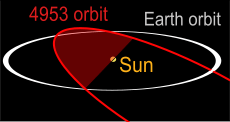Minimum orbit intersection distance

Minimum orbit intersection distance (MOID) is a measure used in astronomy to assess potential close approaches and collision risks between astronomical objects.[1][2] It is defined as the distance between the closest points of the osculating orbits of two bodies. Of greatest interest is the risk of a collision with Earth; the MOID between an object and Earth is called Earth MOID. Earth MOID is often listed on comet and asteroid databases such as the JPL Small-Body Database. MOID values are also defined with respect to other bodies as well: Jupiter MOID, Venus MOID and so on.
An object is classified as a potentially hazardous object (PHO) – that is, posing a possible risk to Earth – if, among other conditions, its Earth MOID is less than 0.05 AU. For more massive bodies than Earth, there is a potentially notable close approach with a larger MOID; for instance, Jupiter MOIDs less than 1 AU are considered noteworthy since Jupiter is the most massive planet.[1]
A low MOID does not mean that a collision is inevitable as the planets frequently perturb the orbit of small bodies. It is also necessary that the two bodies reach that point in their orbits at the same time before the smaller body is perturbed into a different orbit with a different MOID value. Two Objects gravitationally locked in orbital resonance may never approach one another. Numerical integrations become increasingly divergent as trajectories are projected further forward in time, especially beyond times where the smaller body is repeatedly perturbed by other planets. MOID has the convenience that it is obtained directly from the orbital elements of the body and no numerical integration into the future is used.[3]
The only object that has ever been rated at 4 on the Torino Scale (since downgraded), the Aten asteroid (99942) Apophis, has an Earth MOID of 0.0007 AU. This is not the smallest Earth MOID in the catalogues; many bodies with a small Earth MOID are not classed as PHO's because the objects are less than roughly 100 meters in diameter. Earth MOID values are generally more practical for asteroids less than 100 meters in diameter as those asteroids are very dim and often have a small observation arc with a poorly determined orbit. The only objects that have been detected and had their Earth-MOID calculated before Earth impact were the small asteroids 2008 TC3 and 2014 AA. 2008 TC3 was listed with a MOID of 0.00001 AU in the Minor Planet Center database, and is the smallest MOID calculated for an Apollo asteroid.[4] It is even smaller at the more precise JPL Small Body Database (0.0000078 AU).[5]
| Object | Earth MOID (AU) | Size (m) (approximate) | (H) | Currently on Sentry Risk Table |
|---|---|---|---|---|
| (177049) 2003 EE16 | 0.00005 AU (7,500 km; 4,600 mi) | 320 | 19.7 | |
| 2009 WM1 | 0.00009 AU (13,000 km; 8,400 mi) | 280 | 20.4 | |
| (292220) 2006 SU49 | 0.00034 AU (51,000 km; 32,000 mi) | 380 | 19.5 | |
| (137108) 1999 AN10 | 0.00036 AU (54,000 km; 33,000 mi) | 1300 | 17.9 | |
| 2007 TU24 | 0.00042 AU (63,000 km; 39,000 mi) | 250 | 20.3 | |
| (367789) 2011 AG5 | 0.00049 AU (73,000 km; 46,000 mi) | 140 | 21.8 | |
| (308635) 2005 YU55 | 0.00050 AU (75,000 km; 46,000 mi) | 360 | 21.9 | |
| (35396) 1997 XF11 | 0.00061 AU (91,000 km; 57,000 mi) | 2000 | 16.9 | |
| 99942 Apophis | 0.00074 AU (111,000 km; 69,000 mi) | 325 | 19.7 | Yes |
| 2007 VK184 | 0.00076 AU (114,000 km; 71,000 mi) | 130 | 22.0 | Yes |
| 2011 BT15 | 0.00084 AU (126,000 km; 78,000 mi) | 150 | 21.8 | |
| 1997 XR2 | 0.00086 AU (129,000 km; 80,000 mi) | 200 | 20.9 |
See also
- List of Mercury-crossing minor planets
- List of Venus-crossing minor planets
- List of Earth-crossing minor planets
- List of Mars-crossing minor planets
- List of Jupiter-crossing minor planets
- List of Saturn-crossing minor planets
- List of Uranus-crossing minor planets
- List of Neptune-crossing minor planets
References
- ↑ 1.0 1.1 Bruce Koehn, "Minimum Orbital Intersection Distance", Lowell Observatory, retrieved online 14th May 2009.
- ↑ Basics of Space Flight: The Solar System, p3, NASA JPL, retrieved 14th May 2009.
- ↑ Brian G. Marsden, "Press Information Sheet:Potentially Hazardous Asteroids", Harvard-Smithsonian Center for Astrophysics, retrieved online 3rd May 2009.
- ↑ List Of Apollo Minor Planets, International Astronomical Union: Minor Planet Center, retrieved 14th May 2009.
- ↑ 2008 TC3 at JPL Small Body Database. Retrieved 14th May 2009.
- ↑ "JPL Small-Body Database Search Engine: H <= 22 (mag) and Earth MOID < 0.0027 (AU)". JPL Solar System Dynamics. Retrieved 2013-02-01.
External links
- Sentry Risk Table (current) by NEO Program
- List of the Potentially Hazardous Asteroids (PHAs)
- MBPL - Minor Body Priority List ( PHA Asteroids )
- SAEL - Small Asteroids Encounters List
- TECA Table of Asteroids Next Closest Approaches to the Earth
| |||||||||||||||||||||||||||||
| ||||||||||||||||||||||